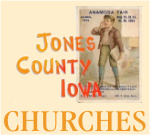In Jackson township, Jones County Iowa, on February 25, 1865—less than two months before the close of the Civil War, and while Abraham Lincoln was yet President of the United States, a small band of pioneer settlers of the Christian denomination, desirous of extending the Gospel Kingdom, and with prayer in their hearts and inspirational zeal held a meeting in the Hay schoolhouse, to lay plans for building the first Antioch church.
Eighty-seven years have passed since the adjournment of that little assembly. On the yellowed pages of the ancient church book—beautifully written in old time script, are to be seen the minutes of that memorable session. How the Rev. Joseph H. Johnson was chosen chairman and William Jeffries secretary, "for the purpose of selecting a location for the House of Worship on the same," Jacob Kramer gave one acre of land.
A committee of three was chosen to select the site, namely: Isaac Hay, F. M. Belknap and Anthony Waggoner.
The report of said committee was as follows: "On the raise of the hill on North side of road running from Anamosa, to Maquoketa, and between the Hay schoolhouse and South-East corner of the same tract of land."
The House was to be built of brick with one foot walls and dimensions of thirty-two by forty feet, and they were to call this church Antioch. Free to all religious denominations when not occupied by the Christians.
A committee of four: F. M. Belknap, Anthony Waggoner, Isaac Hay and William Byerly were appointed to solicit funds for building the church.
The building committee was as follows: Anthony Waggoner, Joseph Apt and Andrew Byerly; with William Jefferies as secretary and Isaac Hay, treasurer. Later, the name of Michael Byerly was added to this group. On March 11, 1865, the building committee was given the right to "proceed forthwith to let the job of construction."
From this time on until after the church was built, the records are very meager. No dates are available of the time the church was actually completed. No mention is made of the dedication. We do know, however, that the church stood for one year with no roof over it.
The wounds of the Civil War were fresh. Times were hard and money was very scarce. On down through the months to follow, we sense the struggle of the little congregation in trying to finish their church. Too well they knew the trials, toil and bitter disappointments that attended their every achievement of that day.
But they also must have known the sweet triumph of success crowned labor, when at last God's House stood before them in all its reverent grace and beauty!
For eighty-five years this sanctuary of Christian faith had weathered the storms of time, a monument to the consecration of our early church goers.
Rev. Joseph H. Johnson, of the Christian denomination, was one of the first pastors of Antioch church. (Rev. Johnson was the grand-father of Mrs. Will Hay and Mrs. Ray Stivers.)
The Rev. Nathan Potter was also an early pastor of this church. Most of the pioneer-day funerals were held at this place.
The first wedding to be held at Antioch was soon after the church was built. A young couple by the name of Ellen Waggoner and John Bean. The former being a daughter of Anthony Waggoner.
Roads were bad and travelling was slow, but in those days it was a privilege to attend church services. Men, women and children would come for miles in wagons, on horse-back or walk to church. Sometimes, services were held in the homes. If it were evening time the Scriptures were read by candle light.
After the Christian organization, came the United Brethern to worship for many years at Antioch. Perhaps, as early as 1885 to 1905.
Some scanty records give the names of the Reverend Moffit, Harper, Cunningham, and Clark as ministers who preached at this place and some very fruitful years are remembered.
The Presbyterians followed with Pastor, the Reverends: Evans, Burhans, Badger and Prevost. The ensueing years were active ones.
One of the largest Sunday Schools in the history of the church was conducted here. Preaching services were held every Sunday, and beautiful musical programs were given.
The Ladies' Aid, called Antioch Social Circle, is the most active group, and for more than forty years has been a great help to the church and surrounding community.
We of today are proud of old Antioch's historical past and early traditions. Let us rejoice in God's goodness for the opportunity that was afforded us in worshiping here. Where bonds of constancy have been forged into lasting fellowships, each year a link in the golden chain.
Old Antioch church burned to the ground on January 3, 1950.
The sturdy band of early settlers who laid the plans for building this church, and many of their decendants have long ago joined that "innumerable caravan which moves to that mysterious realm," but their work here shall endure forever.
Speak reverently the name of the old Country Church. On hallowed ground it stood. It's memory a benediction.







